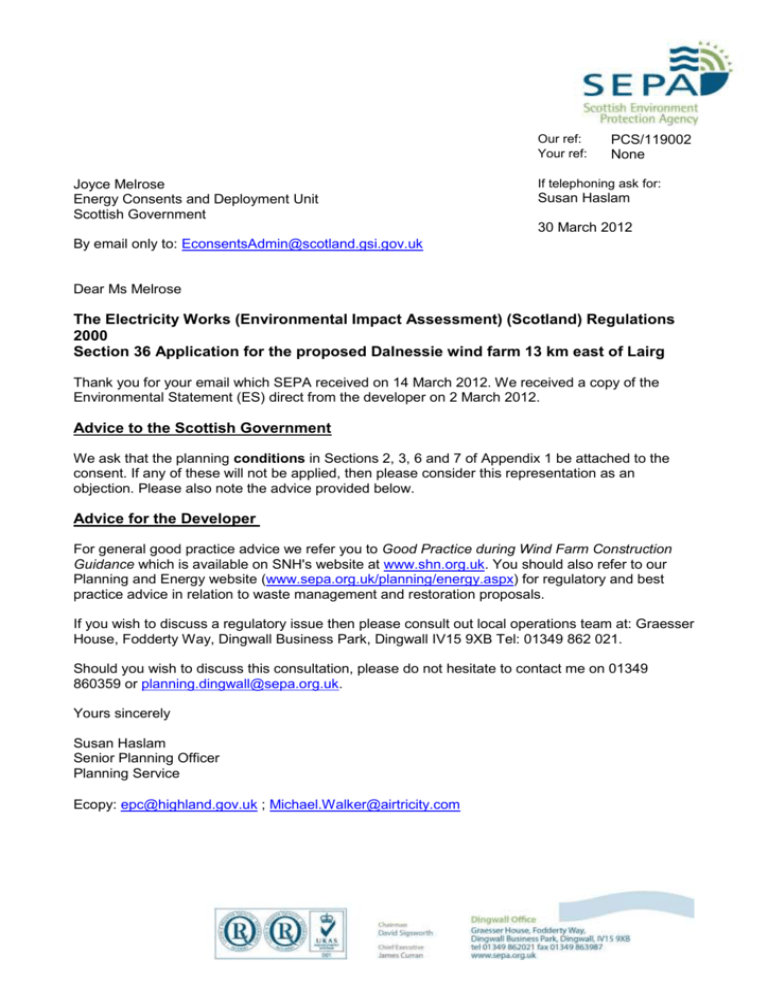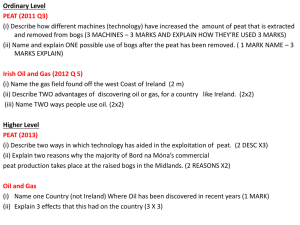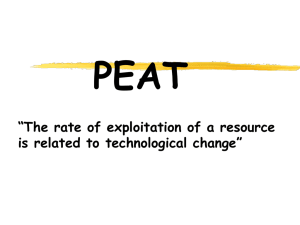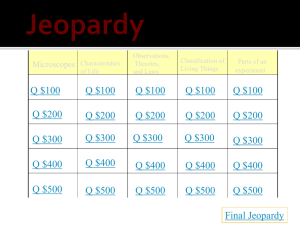4. Borrow pits - The Scottish Government
advertisement

Our ref: Your ref: Joyce Melrose Energy Consents and Deployment Unit Scottish Government PCS/119002 None If telephoning ask for: Susan Haslam 30 March 2012 By email only to: EconsentsAdmin@scotland.gsi.gov.uk Dear Ms Melrose The Electricity Works (Environmental Impact Assessment) (Scotland) Regulations 2000 Section 36 Application for the proposed Dalnessie wind farm 13 km east of Lairg Thank you for your email which SEPA received on 14 March 2012. We received a copy of the Environmental Statement (ES) direct from the developer on 2 March 2012. Advice to the Scottish Government We ask that the planning conditions in Sections 2, 3, 6 and 7 of Appendix 1 be attached to the consent. If any of these will not be applied, then please consider this representation as an objection. Please also note the advice provided below. Advice for the Developer For general good practice advice we refer you to Good Practice during Wind Farm Construction Guidance which is available on SNH's website at www.shn.org.uk. You should also refer to our Planning and Energy website (www.sepa.org.uk/planning/energy.aspx) for regulatory and best practice advice in relation to waste management and restoration proposals. If you wish to discuss a regulatory issue then please consult out local operations team at: Graesser House, Fodderty Way, Dingwall Business Park, Dingwall IV15 9XB Tel: 01349 862 021. Should you wish to discuss this consultation, please do not hesitate to contact me on 01349 860359 or planning.dingwall@sepa.org.uk. Yours sincerely Susan Haslam Senior Planning Officer Planning Service Ecopy: epc@highland.gov.uk ; Michael.Walker@airtricity.com Appendix 1: Detailed comments, recommendations and conditions 1. The Water Environment (Controlled Activities) (Scotland) Regulations (CAR) 1.1 On the basis of the information available and without prejudice to the determination of any corresponding applications for CAR authorisation, we would expect the proposal to fall into Category 1 - ‘capable’ of being authorised. 1.2 We can confirm that we have not received any CAR applications from the developer. For information, modifications to existing small scale culverts are unlikely to require registration under CAR. 2. Direct impacts on the water environment 2.1 While the development will result in a large number of new or upgraded watercourse crossings we are satisfied that the route taken and location of other infrastructure has had due regard for the water environment. We welcome the level of detail provided in the watercourse crossing assessment. 2.2 We welcome the inclusion of a 50 m buffer between infrastructure and watercourses which are considered to have continuous flow and a 25 m buffer adopted for all ephemeral drainage channels (outlined in section 4.9.3 of ES). We ask that this be ensured by condition to ensure that micro-siting does not reduce the level of protection recommended (obviously with the exception of where access tracks specifically require to cross watercourses). 2.3 We note that the ES states that "with the exception of a limited number of watercourse crossing identified no infrastructure is planned in areas susceptible to flooding". Our main issue with regards to windfarm developments and flood risk is in relation to the new access roads and associated watercourse crossings. We are therefore pleased to note that section 4.9.3 also confirms that all watercourse crossings will be designed to accommodate flow. 2.4 We agree with the assessment in section 11 which suggests that the development is not likely to have a significant impact on the private water supply at Dalnessie. Although little information is provided regarding the private water supply at Saval (in the vicinity of the borrow pit site in Dalchork wood) we consider that it is unlikely that the development will have an adverse impact on the water supply for these properties. This is owing to the fact that they lie some 2 km away, in a different watershed and up-gradient of the borrow pit site. 3. Pollution prevention and environmental management 3.1 We welcome the mitigation measures included throughout the ES and the inclusion of a draft CEMP. To ensure that the development does not significantly effect the water environment and protect downstream sensitivities we request that a condition is imposed requiring that a full site specific construction environmental management plan (CEMP) is submitted for approval to the planning authority at least two months prior to the proposed commencement (or relevant phase) of development in order to provide consultees with sufficient time to assess the information. 3.2 This document should address all pollution prevention and environmental management issues related to construction works, including, for example, those relating to peat stability, the borrow pits (including information on cross sections, elevation of the pit floor and confirmation of exact extraction volumes), peat management and reuse and all related environmental monitoring. 3.3 The Non-technical Summary proposes a 100 m micro-siting distance and section 5.3.1 clarifies that micro-siting up to 50 m could be agreed by on-site specialists and micro-siting of between 50 and 100 m would be with the approval of the planning authority and appropriate consultees. We are satisfied with this approach. Details of how micro-siting will be implemented and controlled should be submitted as part of CEMP. 3.4 Please note the issues outlined in sections 4.4, 5.3 and 6.2 of this letter which the CEMP should also address. 4. Borrow pits 4.1 Section 5.3.11 of the ES outlines a requirement for approximately 190,800 m3 of aggregate. We note that borrow pits 1 and 2, which are located in close proximity to the windfarm, are estimated to be able to supply 258,252 m3 of rock, significantly in excess of that estimated to be required for the development. 4.2 Two further borrow pits are however identified. Borrow pits 3 and 4 are a significant distance from the windfarm and if developed will result in the need to upgrade a further 8.8 km of existing forest track (section 4.11.1). We highlight to the determining authority that there does not seem to be a clear need for this element of the development and that the environmental impact of the overall development could be reduced if it were removed. 4.3 We ask that detailed information on the environmental management of the borrow pits, including the information set out in PAN 50 Controlling the environmental effects of surface mineral workings (Paragraph 53) to be included in the requested CEMP. 4.4 Please also note that the hydrogeological behaviour of faults in proximity to borrow pit 4 is not known and therefore it is possible that the bedrock permeability is locally enhanced along the fault line due to a greater fracture density. The fault line could therefore act as preferential pathways for contaminants to enter groundwater and surface water features. We ask that the CEMP specifically include details of the measures to be taken to protect the water environment in relation to this potential issue. 5. Disturbance of peat 5.1 Significant information on peat depth has been collected and in the main we consider that the layout proposed avoids the areas of deepest peat on the site. Nonetheless there are a number of individual turbines which will be located on peat greater than 2 m in depth; micro siting should be used to ensure the final location of the turbines is on the shallowest peat available. 5.2 We would have welcomed it if more description of the elements within Table 11.1 had been provided. We welcome the clear identification of the different elements of excavated material but are disappointed that the calculations of peat to be disturbed is not then classified into these elements. Without treatment there are limited uses for the lower layer of peat, and it would be helpful if at this stage the total amount of this type of peat that will be generated had been calculated and uses and treatment identified. We also note that the calculations do not seem to consider the peat disturbed by upgrading existing tracks (estimated to be 14.8 km) and do not consider the volume of peat disturbed by the borrow pits. In addition it only considers two borrow pits, where as four are now proposed. 5.3 Nonetheless based on the information provided and in this specific instance we consider that it seems likely that suitable uses for any disturbed material can be made. We ask that the finalised CEMP includes a more detailed section on excavated materials which clearly identifies and quantifies all disturbed areas and uses in line with best practice. 6. Impacts on peatland and groundwater dependant terrestrial ecosystems (wetlands) 6.1 We note that large areas of the site are vegetation communities classified as groundwater dependant terrestrial ecosystems. These include M6, M15, M23, M25 and MG10, all of which may be impacted. However, the ES notes that the overall mire system on the site is predominantly ombrotrophic (rain-fed), so the dependency of these habitats on groundwater is likely to be low in this instance. 6.2 Impacts on these habitats are nevertheless possible from alterations to hydrological conditions in the peat, for example if access tracks cut off drainage routes. This is also acknowledged in the ES, and the CEMP proposes drainage arrangements for both floating and cut tracks to minimise effects on existing hydrology. We ask that full details of these methods and mitigation measures are included in the finalised CEMP. 6.3 We welcome the production of a draft Habitat Management Plan (Appendix 9-5) and the proposals for compensatory habitat restoration for blanket bog and wet health and ask that a condition be applied that a finalised Plan be agreed with the planning authority in consultation with SEPA and SNH (and thereafter implemented). 6.4 We welcome the inclusion of a 25 m buffer between infrastructure and acid flush and bog pool features (outlined in section 4.9.5 of ES). We ask that this be ensured by condition to ensure that micro-siting does not reduce the level of protection recommended. 7. Decommissioning and final site restoration 7.1 We request that a condition is applied seeking a Decommissioning and Restoration Plan. The Plan should be submitted at least two years prior to the end of the design life of the development and be based on the best practice current at the time of submission. 8. Carbon balance assessment 8.1 Appendix 2 provides our audit of the carbon balance assessment. 9. Caveats 9.1 Please note that we are reliant on the accuracy and completeness of the information supplied to us in undertaking our review and can take no responsibility for incorrect data or interpretation made by the authors. 9.2 This advice is also given without prejudice to any decision made on elements of the proposal regulated by us. The decision may take into account factors not considered at the planning stage. Appendix 2: Carbon Assessment of Section 36 Wind Farms SECTION 1: SUMMARY OF REPONSE Issue If no, is any deficiency Yes/No significant enough to affect substantially the carbon payback period? Comments Further requirements to enable positive validation (where applicable) Is there sufficient confidence in the carbon payback figure for it to be used by Scottish Ministers as a material consideration in their decision making? No Some information is missing, in particular no values are given for maximum and minimum carbon payback periods, as only expected values have been entered into the carbon payback spreadsheet. Section 15.8 – Climate and Carbon Emissions in the Environmental Statement requires to be expanded to further clarify the rationale behind all the data input in the carbon assessment. The level of significance will depend on further information to be provided by the developer for some of the data incorporated in the carbon calculator. A number of sensitivity analyses have been carried out to assess how some of the potential deficiencies affect the carbon payback period - See section 2. Reference for all the data input in the carbon calculator needs to be recorded in the relevant input data sheets. Provision of maximum and minimum values in the carbon assessment tool. SECTION 2: DETAILED RESPONSE Issue Yes/ No If no, is any deficiency significant enough to affect substantially the carbon payback period? Comments Is all relevant data inputted as set out in the tool? No No maximum or minimum values are given for any of the INPUT DATA Maximum and minimum values should be entered Further requirements to enable positive validation (where applicable) Data on the relevant carbon calculator input parameters, therefore it is difficult to assign a level of confidence to the carbon payback results. in the data input sheets of the carbon calculator so that a confidence range for carbon payback time can be calculated. maximum and minimum values associated to each parameter is required. The source of the data have not been recorded in the carbon calculator. A number of sensitivity analyses have been carried out to assess how some of the potential deficiencies affect the carbon payback period. The results of these analyses are presented in the comments column. CORE INPUT DATA The source of all the data provided in the carbon calculator should be recorded in the carbon calculator. Windfarm characteristics Further justification/rationale behind the assumed capacity factor should be provided. If the average 28% Scottish factor based on 2009 data from Energy Trends is used, then payback period for the expected values scenario would be extended by 2 months (10% increase) for the fossil fuel mix scenario. Counterfactual emission factors The most recent values for the three required counterfactual factors, according to the latest DUKES publication (July 2011) - Table 5a are: Grid mix: 0.458t CO2 MWh-1, fuel mix: 0.59t CO2 MWh-1 and coal: 0.909t CO2 MWh-1 Further justification/rationale behind the assumed capacity factor should be provided. It is recommended that the most recent values for the three counterfactual factors are used. If these values are used in the carbon calculator the carbon payback period for the expected values scenario would be slightly extended by: 0.6 months (2% increase) for the fossil fuel mix scenario, and decreased by 2 months (6% decrease) for the coal scenario and 1 month (5% decrease) for the grid mix scenario. Does the data correspond with the information provided in the Environmental Statement? No The level of significance will depend on the further clarification for some of the data incorporated in CORE INPUT DATA Forestry plantation characteristics: The area of forestry to be felled is not identified in the Environmental Statement and the rationale Further clarification on this data is required. the carbon calculator to be provided by the developer. behind the average rate of carbon sequestration emission factor input in the carbon calculator has not been provided. Some sensitivity analyses have been carried out to assess how some of the potential deficiencies affect the carbon payback period. The results of these analyses are presented in the comments column. Characteristics of peatland before windfarm development The source or rationale behind the data provided for average air temperature at site and C content of dry peat has not been provided. Average water table depth is given as 0.2 m. However, 0.1 m is more likely for intact blanket bog. Was the 0.2 m value determined by on-site measurement? If so, this needs to be clarified, and methods used outlined. Further clarification on the data used for extent of drainage around drainage features is required. The methodology for calculating the average depth of peat at site is not provided. Borrow pits The borrow pits length and width data provided in the TA A5.2 Borrow Peat Assessment report of the Environmental Statement is not consistent with the data provided in the carbon calculator. The 0.0 m expected figure for average depth of peat removed from borrow pits is not credible. At least one of the borrow pits is in an area of peat as indicated by the superficial geology map (fig. 11.7). The others, according to TA A5.2 Borrow Peat Assessment report of the Environmental Statement, have some peat cover. Access tracks The length of floating and excavated roads and The source and rationale behind this data is required. Further clarification is required. Further clarification is required. The methodology for calculating this data is required. Further clarification of the data is required Further clarification/revision of this data is required. Further clarification and referencing of the data within this section is the length of floating road that is drained input in the carbon assessment are inconsistent with the data identified in the Environmental Statement. In addition, the Environmental Statement does not mention the construction of any rock filled roads, however, 26,300 m of it is reported in the carbon calculator. Improvement of C sequestration Clarification and further referencing of the water table data and time required from restoration data has not been provided. Choice of methodology for calculating emission factors The methodology chosen for calculation of emission factors was the IPCC default instead of the site specific methodology. If the site specific methodology is used, then payback period for the expected values scenario would be decreased by almost 1 months (3% decrease) for the fossil fuel mix scenario. CONSTRUCTION INPUT DATA required. Further clarification and referencing of the data within this section is required. It is recommended that the ‘site specific values’ methodology is used as site specific values are available. The total volume of concrete used on site is required. Volume of concrete The volume of concrete input in the carbon calculator corresponds to the volume of concrete use per turbine. However, the total volume of concrete used on site should be reported. Is there sufficient evidence that peat/soil depth measurements have been probed to full depth? Yes However, there are a number of peat probe points for which recorded depth is mostly given as 3 m which are accompanied by the comments ‘Depth not proven’ or ‘unknown’ in the substrate column. Does the data (including peat depth) correspond with the Yes The Peat Landslide Hazard Risk Assessment Report presented in Appendix 5.1 Peat Landslide and Hazard Risk Assessment of the Clarification is needed to explain what ‘depth not proven’ and ‘unknown’ mean. information in the Halcrow peat slide assessment? Is the data credible? Environmental Statement refers to and identifies that the methods adopted for the assessment follow the requirements identified in the Halcrow Peat Slide Assessment. No The level of significance will depend on the further clarification of inconsistencies and rationale behind some of the figures identified in this section. Data values have been used without referencing or justification. No explanation of measurement methods has been supplied. There are some inconsistencies between the figures and references identified in the Environmental Statement and the carbon calculator, particularly values related to measurements and peat depths associated to borrow pits and access tracks. In addition, further clarification on the values provided for some of the parameters identified in section 2 is needed. SECTION 3: GOOD PRACTICE Issue Is there potential to reduce the carbon payback through improved adherence to the SEPA/SNH Good practice during wind farm construction guidance and/or SEPA’s Regulatory Position Statement for Development on Peat? No – proposal adheres to good practice While reference to SEPA/SNH good practice is made throughout the document, it is essential that this, together with the requirements under SEPA’s Regulatory Position Statement for Developments on Peat, are fully carried out in practice. Yes – improved adherence would improve the carbon payback Where applicable specify areas of good practice that could be introduced to improve the carbon payback of the proposal







